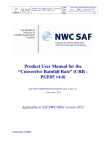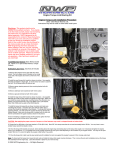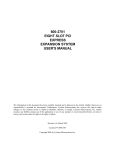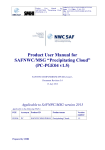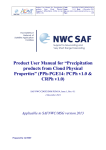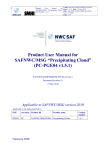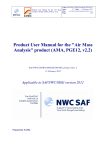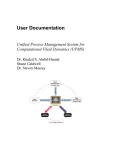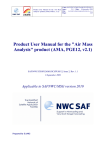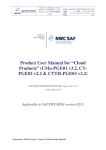Download Product User Manual for the "Convective Rainfall Rate
Transcript
Code: SAF/NWC/CDOP/INM/SCI/PUM/05 Product User Manual for the “Convective Issue: 3. 1 Date: 11 May 2010 Rainfall Rate” (CRR -PGE05 v3.1) File: SAF-NWC-CDOP-INM-SCI-PUM-05_v3.1.doc Page: 1/32 Product User Manual for the “Convective Rainfall Rate” (CRR PGE05 v3.1) SAF/NWC/CDOP/INM/SCI/PUM/05, Issue 3, Rev. 1 11 May 2010 Applicable to SAFNWC/MSG version 2010 Prepared by AEMET Code: SAF/NWC/CDOP/INM/SCI/PUM/05 Product User Manual for the “Convective Issue: 3. 1 Date: 11 May 2010 Rainfall Rate” (CRR -PGE05 v3.1) File: SAF-NWC-CDOP-INM-SCI-PUM-05_v3.1.doc Page: 2/32 REPORT SIGNATURE TABLE Function Prepared by Reviewed by Name Antonio Rodríguez (AEMET) Date 11 May 2010 Cecilia Marcos (AEMET) Marcelino Manso (AEMET) Pilar Fernández (AEMET) Authorised by Signature SAFNWC Project Manager 11 May 2010 11 May 2010 Code: SAF/NWC/CDOP/INM/SCI/PUM/05 Product User Manual for the “Convective Issue: 3. 1 Date: 11 May 2010 Rainfall Rate” (CRR -PGE05 v3.1) File: SAF-NWC-CDOP-INM-SCI-PUM-05_v3.1.doc Page: 3/32 DOCUMENT CHANGE RECORD Version Date Pages CHANGE(S) Doc code SAF/NWC/CDOP/INM/SCI/PUM/05 3.0 2 March 2009 30 Initial version (content derived from Software User Manual for PGE05 (Convective Rainfall Rate) of the SAFNWC/MSG: scientific part) Indications and recommendations given by the DRI MSG 2009 have been included. 3.1d 3.1 2 February 2010 11 May 2010 32 32 Document updated for the SAFNWC/MSG PGE05 v3.1 and submitted for DRI 2010: CRR rain rate algorithm retrieval updated to work using lightning data information (SPR 374 / SMR 352). Revised document following the indications and recommendations given by the DRI-2010 Code: SAF/NWC/CDOP/INM/SCI/PUM/05 Product User Manual for the “Convective Issue: 3. 1 Date: 11 May 2010 Rainfall Rate” (CRR -PGE05 v3.1) File: SAF-NWC-CDOP-INM-SCI-PUM-05_v3.1.doc Page: 4/32 Table of contents 1. INTRODUCTION ...................................................................................................................6 1.1 SCOPE OF THE DOCUMENT .......................................................................................................6 1.2 SCOPE OF OTHER DOCUMENTS.................................................................................................6 1.3 SOFTWARE VERSION IDENTIFICATION .....................................................................................6 1.4 IMPROVEMENTS FROM PREVIOUS VERSION ..............................................................................6 1.5 ACRONYMS .............................................................................................................................7 1.6 REFERENCES ...........................................................................................................................8 1.6.1 Applicable Documents...................................................................................................8 1.6.2 Reference Documents ....................................................................................................8 2. DESCRIPTION OF THE CONVECTIVE RAINFALL RATE (CRR) PRODUCT ........9 2.1 GOAL OF THE CONVECTIVE RAINFALL RATE (CRR) PRODUCT ................................................9 2.2 ALGORITM OUTLINE OF CONVECTIVE RAINFALL RATE (CRR)................................................9 2.2.1 Processing of the Convective Rainfall Rate (CRR) .......................................................9 2.2.2 Convective Rainfall Rate (CRR) calibration matrices description .............................10 2.2.3 Convective Rainfall Rate (CRR) correction factors ....................................................11 2.2.4 Lightning algorithm.....................................................................................................13 2.3 DESCRIPTION OF THE CONVECTIVE RAINFALL RATE (CRR) OUTPUTS...................................13 3. IMPLEMENTATION OF THE CONVECTIVE RAINFALL RATE (CRR) PRODUCT17 3.1 3.2 3.3 INSTALLATION STEP FOR CONVECTIVE RAINFALL RATE (CRR) ............................................17 PREPARATION STEP FOR CONVECTIVE RAINFALL RATE (CRR) .............................................17 EXECUTION STEP FOR CONVECTIVE RAINFALL RATE (CRR).................................................17 4. INPUTS AND CONFIGURABLE PARAMETERS FOR CONVECTIVE RAINFALL RATE (CRR) PRODUCT.............................................................................................................19 4.1 LIST OF INPUTS FOR CONVECTIVE RAINFALL RATE (CRR) ...................................................19 4.1.1 Convective Rainfall Rate (CRR) dynamic inputs.........................................................19 4.1.2 Convective Rainfall Rate (CRR) static inputs..............................................................20 4.2 LIST OF CONFIGURATION PARAMETERS FOR CONVECTIVE RAINFALL RATE (CRR) ...............20 4.2.1 Keywords table for Convective Rainfall Rate (CRR) ..................................................21 4.2.2 Keywords description for Convective Rainfall Rate (CRR) ........................................26 5. SUMMARY OF CONVECTIVE RAINFALL RATE (CRR) PRODUCT VALIDATION RESULTS............................................................................................................28 5.1 5.2 INSTANTANEOUS RATES ........................................................................................................28 HOURLY ACCUMULATIONS ...................................................................................................29 6. CONVECTIVE RAINFALL RATE (CRR) PRODUCT ASSUMPTIONS AND LIMITATIONS .............................................................................................................................30 7. EXAMPLE OF CONVECTIVE RAINFALL RATE (CRR) PRODUCT VISUALISATION .........................................................................................................................31 7.1.1 7.1.2 Instantaneous Rates.....................................................................................................31 Hourly Accumulations .................................................................................................32 Code: SAF/NWC/CDOP/INM/SCI/PUM/05 Product User Manual for the “Convective Issue: 3. 1 Date: 11 May 2010 Rainfall Rate” (CRR -PGE05 v3.1) File: SAF-NWC-CDOP-INM-SCI-PUM-05_v3.1.doc Page: 5/32 List of Tables and Figures Table 1: List of Applicable Documents.............................................................................................8 Table 2. List of Reference Documents ..............................................................................................8 Table 3. 2D Calibration matrices structure......................................................................................10 Table 4. 3D Calibration matrices structure......................................................................................10 Table 5. CRR classes.......................................................................................................................13 Table 6. CRR SEVIRI inputs ..........................................................................................................19 Table 7. Keywords table..................................................................................................................25 Table 8. Accuracy statistics for instantaneous rates ........................................................................28 Table 9. Categorical statistics for instantaneous rates.....................................................................28 Table 10. Accuracy statistics for hourly accumulations..................................................................29 Table 11. Categorical statistics for hourly accumulations...............................................................29 Figure 1. CRR palette ......................................................................................................................14 Figure 2. CRR classes output corresponding to 11th September 2008 at 16:00Z...........................31 Figure 3. CRR hourly accumulations output corresponding to 11th September 2008 at 16:30Z ....32 Code: SAF/NWC/CDOP/INM/SCI/PUM/05 Product User Manual for the “Convective Issue: 3. 1 Date: 11 May 2010 Rainfall Rate” (CRR -PGE05 v3.1) File: SAF-NWC-CDOP-INM-SCI-PUM-05_v3.1.doc Page: 6/32 1. INTRODUCTION The EUMETSAT “Satellite Application Facilities” (SAF) are dedicated centres of excellence for processing satellite data, and form an integral part of the distributed EUMETSAT Application Ground Segment (http://www.eumetsat.int). This documentation is provided by the SAF on Support to Nowcasting and Very Short Range Forecasting, SAFNWC. The main objective of SAFNWC is to provide, further develop and maintain software packages to be used for Nowcasting applications of operational meteorological satellite data by National Meteorological Services. More information can be found at the SAFNWC webpage, http://www.nwcsaf.org. This document is applicable to the SAFNWC processing package for Meteosat satellites meteorological satellites, SAFNWC/MSG. 1.1 SCOPE OF THE DOCUMENT This document is the Product User Manual (PUM) for the MSG product PGE05 (CRR) and contains practical information on the characteristics of the product, including the input data and the output product. It also gives information about the algorithm’s implementation and configuration. 1.2 SCOPE OF OTHER DOCUMENTS The Algorithm Theoretical Basis Document contains information about the product objectives, the algorithm scientific description, the needed input data and the output product [AD.1]. The Validation Report version v1.0 of the PGE05 document [AD.2], showing the validation results for PGE05 v3.1, that give information about the extended validation performed over Spain for a complete year period instead of the summer period and the validation over Hungary against radar data. Besides, a comparison with the validation performed by OMSZ against rain gauge data is also presented in this document. The Interface Control Documents ICD/1 [AD.3] describes the External and Internal Interfaces of the SAFNWC/MSG software. The Interface Control Documents ICD/3 [AD.4] describes the input and output data formats of the SAFNWC/MSG software. The Architectural Design Document [AD.5] presents the general architecture of the SAFNWC software, and gives details on each PGE (interface with the SAFNWC software, architecture of each PGE). 1.3 SOFTWARE VERSION IDENTIFICATION This document describes the algorithm implemented in the PGE05 version v3.0 of SAFNWC software package delivery. 1.4 IMPROVEMENTS FROM PREVIOUS VERSION As lightning activity is related to convection, this information has been added as a new input in order to improve the product results. This new input is optional and entails a number of Code: SAF/NWC/CDOP/INM/SCI/PUM/05 Product User Manual for the “Convective Issue: 3. 1 Date: 11 May 2010 Rainfall Rate” (CRR -PGE05 v3.1) File: SAF-NWC-CDOP-INM-SCI-PUM-05_v3.1.doc Page: 7/32 configurable parameters that are described in the Keywords description for Convective Rainfall Rate (CRR) section. The improvements are shown in the Validation Report [AD.2]. Due to the incorporation of the lightning information input, the currently CRR_QUALITY output contains more information. This information can also be found in the Interface Control Document [AD.3]. During the subjective validation it has been confirmed the negative effect of using the solar channel when the sun zenith angle is higher than 80º. So it is recommended setting the keyword “DAY_NIGHT_ZEN_THRESHOLD” to 80. This will be the default value used in the CRR v3.1 model configuration file. 1.5 ACRONYMS ATBD Algorithm Theoretical Basis Document CRR Convective Rainfall Rate BALTRAD Baltic Radar Network CSI Critical Success Index 2-D Bi-dimensional 3-D Tri-dimensional EUMETSAT European Organisation for the Exploitation of Meteorological Satellites FAR False Alarm Ratio HRIT High Rate Information Transmission ICD Interface Control Document INM Instituto Nacional de Meteorología IR Infrared MAE Mean Absolute Error ME Mean Error MSG Meteosat Second Generation NWCLIB Nowcasting SAF Library OMSZ Hungarian Meteorological Service PC Percentage of Corrects PGE Product Generation Element POD Probability of Detection PUM Product User Manual PWRH Moisture Correction Factor RAINSAT Rainfall Satellite Technique RMS Root Mean Square error SAF Satellite Application Facility Code: SAF/NWC/CDOP/INM/SCI/PUM/05 Product User Manual for the “Convective Issue: 3. 1 Date: 11 May 2010 Rainfall Rate” (CRR -PGE05 v3.1) File: SAF-NWC-CDOP-INM-SCI-PUM-05_v3.1.doc Page: 8/32 SAF NWC Satellite Application Facility for Nowcasting SEVIRI Spinning Enhanced Visible and Infrared Imager SUM Software User Manual SW Software VIS Visible WV Water Vapour 1.6 REFERENCES 1.6.1 Applicable Documents Reference Title Code Vers Date [AD.1] Algorithm Theoretical Basis SAF/NWC/CDOP/INM/SCI/A TBD/05 Document for ”Convective Rainfall Rate” (CRR - PGE05 v3.1) 3.1 11/05/10 [AD.2] Validation Report for “Convective SAF/NWC/CDOP/INM/SCI/V R/06 Rainfall Rate” (CRR-PGE05 v3.1) 1.0 11/05/10 [AD.3] Interface Control Document for the SAF/NWC/CDOP/INM/SW/I CD/1 External and Internal Interfaces of the SAFNWC/MSG 4.0 12/05/10 [AD.4] SAFNWC/MSG Output Format Definition 4.0 12/05/10 [AD.5] Architectural Design Document for SAF/NWC/CDOP/INM/SW/A D/4 the AEMET- related PGEs of the SAFNWC/MSG 4.0 12/05/10 [AD.6] NWCSAF Product Document 1.0 28/07/09 Products SAF/NWC/CDOP/INM/SW/I CD/3 Requirements SAF/NWC/CDOP/INM/MGT/ PRD Table 1: List of Applicable Documents 1.6.2 Reference Documents Reference [RD.1] Title Lábó, E., Putsay, M., Kocsis, Z. and Szenyán, I. 2009: Cross-verification of the Rapid Developing Thunderstorm and the precipitation products of the Nowcasting and Very Short-Range Forecasting SAF. Help Desk VS Reports. [RD.2] Table 2. List of Reference Documents Code: SAF/NWC/CDOP/INM/SCI/PUM/05 Product User Manual for the “Convective Issue: 3. 1 Date: 11 May 2010 Rainfall Rate” (CRR -PGE05 v3.1) File: SAF-NWC-CDOP-INM-SCI-PUM-05_v3.1.doc Page: 9/32 2. DESCRIPTION OF THE CONVECTIVE RAINFALL RATE (CRR) PRODUCT 2.1 GOAL OF THE CONVECTIVE RAINFALL RATE (CRR) PRODUCT The CRR algorithm developed within the SAF NWC context estimates rainfall rates from convective systems, using IR, WV and VIS MSG SEVIRI channels and calibration matrices generated from both SEVIRI and Radar data. This product can be obtained for every SEVIRI slot that is every 15 minutes in the normal mode. It is also prepared to run in the Rapid Scan mode with a temporal resolution of 5 minutes. 2.2 ALGORITM OUTLINE OF CONVECTIVE RAINFALL RATE (CRR) 2.2.1 Processing of the Convective Rainfall Rate (CRR) The basic CRR mm/h value for each pixel is obtained from the calibration matrices. Composite radar data are compared pixel by pixel with geographically matched MSG data in the same resolution, and the rainfall rate R is obtained, as a function of two or three variables (IR brightness temperature, IR-WV brightness temperature differences and normalised VIS reflectances): R = f (IR, IR-WV, VIS), for 3-D calibration R = f (IR, IR-WV), for 2-D calibration The retrieval of the basic CRR values can be latitude dependant or not. This option can be chosen by the user through the CRR model configuration file. See List of configuration parameters for Convective Rainfall Rate (CRR) of this document. When the CRR retrieval is latitude dependant, it is needed to use Spanish and difference matrices. The difference matrices are built with the differences between the elements of the Nordic and Spanish matrices. When the CRR retrieval is not latitude dependant, the basic rainfall rate retrieved over a particular region will be directly read from regional matrices. For the time being only Spanish and Nordic regional matrices have been computed, nevertheless users can include and name their own regional matrices. A filtering process is performed in order to eliminate stratiform rain data which are not associated to convective clouds: the obtained basic CRR data are set to zero if all the pixels in a grid of a selected semisize (def. value: 3pix) centred on the pixel have a value lower than a selected threshold (def. value: 3mm/h). The threshold and the size of the grid can be modified by the user through the model configuration file. To take into account the temporal and spatial variability of the cloud tops, the amount of moisture available to produce rain and the influence of orographic effects on the precipitation distribution, several correction factors can be applied to the basic CRR value by the users. So that, the possible correction factors are the moisture correction, the cloud top growth/decaying rates or evolution correction, the cloud top temperature gradient correction, the parallax correction and the orographic correction. Code: SAF/NWC/CDOP/INM/SCI/PUM/05 Product User Manual for the “Convective Issue: 3. 1 Date: 11 May 2010 Rainfall Rate” (CRR -PGE05 v3.1) File: SAF-NWC-CDOP-INM-SCI-PUM-05_v3.1.doc Page: 10/32 At this stage, the CRR precipitation pattern computed in the previous step is combined with a precipitation pattern derived through a lightning algorithm. At the end of the process the final values of the CRR rainfall rates are used in order to obtain five different outputs as described in section 2.3. 2.2.2 Convective Rainfall Rate (CRR) calibration matrices description All the calibration matrices must be placed in $SAFNWC/import/Aux_data. 2.2.2.1 2-D Matrix This matrix provides the basic CRR Rainfall rate value (mm/h) depending on the IR brightness temperature and the IR-WV brightness temperature differences. The T10.8 range is divided into 51 classes from 203K to 303K, every 2K. The IR-WV brightness temperature differences are divided into 41 classes from -21K to 59K, every 2K. Axis Parameter Units Origin of axis Step Number of elements 1 IR108-WV62 K -21K +2 K 41 2 IR108 K 203 K +2 K 51 Table 3. 2D Calibration matrices structure 2.2.2.2 3-D Matrix This matrix provides the basic CRR Rainfall rate value (mm/h) depending on the IR brightness temperature, the IR-WV brightness temperature differences and the VIS normalized reflectances. The T10.8 range is divided into 19 classes from 203K to 275K, every 4K. The IR-WV brightness temperature differences are divided into 40 classes from -19K to 59K, every 2K. The VIS normalized reflectances range is divided into 50 classes from 1% to 99% every 2%. Axis Parameter Units Origin of axis Step Number of elements 1 IR108-WV62 K -19 K +2 K 40 2 VIS-N % 1% +2 % 50 3 IR108 K 203 K +4 K 19 Table 4. 3D Calibration matrices structure Code: SAF/NWC/CDOP/INM/SCI/PUM/05 Product User Manual for the “Convective Issue: 3. 1 Date: 11 May 2010 Rainfall Rate” (CRR -PGE05 v3.1) File: SAF-NWC-CDOP-INM-SCI-PUM-05_v3.1.doc Page: 11/32 2.2.2.3 Difference Matrices The 2-D and 3-D difference matrices, which are necessary in order to apply the latitude correction to the basic CRR rainfall rate retrieved, have the same structure as the 2-D and 3-D ones described above. These matrices have been obtained with the differences between the elements of the Nordic and Spanish matrices. 2.2.2.4 Calibration matrices use The latitude dependant option is used by default. In this case two different matrices are needed: the Spanish and the difference matrices. The names of these matrices for this option are CRR_EUR_2D.dat and CRR_EUR_3D.dat for the basic values, and CRR_DIFFS_2D.dat and CRR_DIFFS_3D.dat for the latitude correction. Only these matrices must be used with the latitude dependant option. The CRR retrieval can be chosen not to be latitude dependant. This can be carried out through the configuration file setting the APPLY_DIFF_MATRIX keyword to zero. In this case the basic rainfall rate retrieved over a particular region will be directly read from regional matrices. The names of the available regional matrices are CRR_SP_2D.dat, CRR_SP_3D.dat, CRR_NOR_2D.dat and CRR_NOR_3D.dat, which have been calibrated with data from the Spanish region and the Baltic region respectively. 2.2.3 Convective Rainfall Rate (CRR) correction factors Moisture Correction Factor When thunderstorms take place in quite moist environments the computed rainfall rate should be greater than when they occur in dry air masses. To consider this effect a moisture correction factor has been developed. It adjusts the estimates when the air is dry or quite moist. This factor has been defined as the product of the total precipitable water, PW, in the layer from surface to 500 hPa. by the relative humidity, RH, (mean value between surface and 500 hPa. level), obtained from a numerical model. An environment is considered to be dry if PWRH is significantly below 1.0 and quite moist if PWRH is greater than 1.0. The PWRH factor decreases rainfall rates in very dry environments and increases them in very moist ones. Cloud Growth Rate Correction Factor Convective rain is assumed to be associated with growing clouds exhibiting overshooting tops. Consecutive satellite IR images are used to indicate vertically growing and decaying cloud systems. The cloud growth correction factor, also designated as evolution correction factor, only changes the magnitude of the rain rate through a coefficient if the analysed pixel becomes warmer in the second image. The coefficient value can be modified by the user through the keyword COEFF_EVOL_GRAD_CORR_00 in the model configuration file (Default value for Normal Mode (0.35) is set in the configuration file. Recommended value for Rapid Scan mode is 0.55). The cloud growth rate correction factor can not be applied when consecutive images are not available. In this case the alternative method of Cloud-top Temperature Gradient Correction is applied. Code: SAF/NWC/CDOP/INM/SCI/PUM/05 Product User Manual for the “Convective Issue: 3. 1 Date: 11 May 2010 Rainfall Rate” (CRR -PGE05 v3.1) File: SAF-NWC-CDOP-INM-SCI-PUM-05_v3.1.doc Page: 12/32 Cloud-top Temperature Gradient Correction Factor This alternative correction method is based on the fact that much information can be extracted from the cloud-top structure on a single IR image. This correction factor, also designated as gradient correction factor, is based on a search of the highest (coldest) and lowest (less cold) cloud tops. The idea is to search for the pixels that are below the average cloud top surface temperature (local temperature minima) and assume these pixels indicate active convection associated with precipitation beneath. The hessian of the temperature field is analysed for each pixel with a temperature lower than 250K, in order to search for those pixels with extreme values as is explained in the Algorithm Theoretical Basis Document [AD.1]. Rain rate corresponding to those pixels which have a maximum (meaning that are warmer than its surroundings) is modified by multiplying a coefficient. The value of that coefficient can be selected by the user through the keyword COEFF_EVOL_GRAD_CORR_01 in the model configuration file (Default value: 0.25). In those pixels which have neither a local IR temperature maximum nor minimum, the rain rate is modified through a coefficient controlled by the keyword COEFF_EVOL_GRAD_CORR_02 (Default value: 0.50). Otherwise rain rate is not modified. Parallax correction To apply the orographic correction factor is necessary to know the exact cloud position with respect to the ground below. This is not a problem when a cloud is located directly below the satellite; however, as one looks away from the sub-satellite point, the cloud top appears to be farther away from the satellite than the cloud base. This effect increases as you get closer to the limb and as clouds get higher. The parallax correction depends on three factors: a) the cloud height, b) the apparent position on the earth of that cloud and c) the position of the satellite. The last two factors are known, but the first one has to be estimated. Two height estimation methods have been studied: numerical model and climatological profile obtained from the 1962 standard atmosphere model. Both of them are based on the conversion of each IR10.8 brightness temperature to height. By default, height is estimated using NWP data. When the Parallax Correction is working, a spatial shift is applied to every pixel with precipitation according to the basic CRR value. If in this re-mapping process two pixels of the original image are assigned to the same pixel of the final image, the algorithm takes the maximum value of the rainfall rate, and if a pixel of the final image is not associated to any pixel of the original image (a “hole” appears in the final image), the software identifies the pixels with “hole” and assigns to them a value of the rainfall rate that is the result of applying a 3x3 median filter centred on the hole pixel. Orographic correction factor Local topography has long been recognised to have an effect on the distribution and intensity of precipitation. However, the rain induced by orographic forcing is a complex process associated with complicated flows. Rainfall amounts are dependent on the atmospheric flow over the mountains and on the characteristics of the flow disturbances created by the mountains themselves. This correction factor uses the interaction between the wind vector (corresponding to 850 hPa level from the NWP) and the local terrain height gradient in the wind direction to create a multiplier that enhances or diminishes the previous rainfall estimate, as appropriate. Code: SAF/NWC/CDOP/INM/SCI/PUM/05 Product User Manual for the “Convective Issue: 3. 1 Date: 11 May 2010 Rainfall Rate” (CRR -PGE05 v3.1) File: SAF-NWC-CDOP-INM-SCI-PUM-05_v3.1.doc Page: 13/32 2.2.4 Lightning algorithm As lightning activity is related with convection, this information has been added to the product. Only Cloud-to-Ground lightning flashes are used by this algorithm. To incorporate this information into the product a rain rate has been assigned to every lightning depending on: - the time distance (Δτ) between the lightning event and scanning time of the processing region centre. - the location of the lightning - the spatial density of lightning in a time interval Once the precipitation pattern has been computed, it is compared to the CRR precipitation pattern in order to obtain the final product. This final product contains the highest rain rate of the two. 2.3 DESCRIPTION OF THE CONVECTIVE RAINFALL RATE (CRR) OUTPUTS CRR product is coded in HDF5 format. The available outputs are the following: CRR classes: The rainfall rates obtained by the CRR algorithm expressed in mm/h are converted into eleven classes as it is shown bellow: CLASSES RAINFALL RATE (mm/h) 0 rate < 1 1 1 = rate < 2 2 2 = rate < 3 3 3 = rate < 5 4 5 = rate < 7 5 7 = rate < 10 6 10 = rate < 15 7 15 = rate < 20 8 20 = rate < 30 9 30 = rate < 50 10 rate ≥ 50 Table 5. CRR classes Code: SAF/NWC/CDOP/INM/SCI/PUM/05 Product User Manual for the “Convective Issue: 3. 1 Date: 11 May 2010 Rainfall Rate” (CRR -PGE05 v3.1) File: SAF-NWC-CDOP-INM-SCI-PUM-05_v3.1.doc Page: 14/32 This output includes the following palette: Figure 1. CRR palette CRR hourly accumulations: Rainfall rates from the images in the last hour are used in order to compute the hourly accumulation. This output is expressed in mm and includes a palette that uses the same colours as the classes output palette. CRR intensity in mm/h: Rainfall rates in mm/h are necessary to calculate the hourly accumulation. This is the reason for the existence of this output. It is not intended to be used as a Nowcasting tool, therefore it has no palette. Code: SAF/NWC/CDOP/INM/SCI/PUM/05 Product User Manual for the “Convective Issue: 3. 1 Date: 11 May 2010 Rainfall Rate” (CRR -PGE05 v3.1) File: SAF-NWC-CDOP-INM-SCI-PUM-05_v3.1.doc Page: 15/32 CRR_QUALITY: 8 bits mask indicating which corrections have been applied for each pixel. Moreover, it indicates whether the product is latitude dependant or not, and if the SEVIRI solar channel and the lightning information have been used during the computation of the CRR: 1 bit for moisture correction: 0: No correction 1: Corrected by PWHR factor 1 bit for cloud growth rate correction: 0: No correction 1: Corrected by IR data from previous slot 1 bit for cloud top temperature correction: 0: No correction 1: Corrected by IR temperature gradient 1 bit for parallax correction: 0: No correction 1: Corrected by parallax 1 bit for orographic effect correction: 0: No correction 1: Corrected by orographic effects 1 bit for latitude dependant: 0: No latitude dependant 1: Latitude dependant 1 bit for solar channel used: 0: No solar channel used 1: Solar channel used 1 bit for lightning information used: 0: No lightning information used 1: Lightning information used Code: SAF/NWC/CDOP/INM/SCI/PUM/05 Product User Manual for the “Convective Issue: 3. 1 Date: 11 May 2010 Rainfall Rate” (CRR -PGE05 v3.1) File: SAF-NWC-CDOP-INM-SCI-PUM-05_v3.1.doc Page: 16/32 CRR_DATAFLAG: 8 bits mask indicating the processing status of each pixel: 1 bit for IR10.8, WV6.2 or VIS0.6 data missing 0: All the channel data required are available 1: There is a missing data in some channel 1 bit to indicate if the set of SEVIRI data is out of the calibration matrices range 0: The set of SEVIRI data is contained in the calibration matrices range 1: The set of SEVIRI data is out of the calibration matrices range 1 bit to identify mathematical errors 0: No mathematical error 1: A mathematical error has occurred 1 bit for the convective filter 0: The CRR value remains the same 1: The CRR value has been set to zero because of the filtering process 1 bit for the filled holes after parallax correction 0: No hole due to the parallax correction 1: Hole due to the parallax correction filled by a median filter 2 bits the hourly accumulation CRR band status 0: All required bands were available 1: One previous CRR band is missing 2: At least two previous CRR bands are missing (no consecutive) 3: At least two previous CRR bands are missing (some are consecutive) 1 bit for the status of the CRR pixels used to compute the hourly accumulation 0: All the pixels used in the computing of the hourly accumulation have their CRR_DATAFLAG bits set to 0 1: At least one of the pixels used in the computing of the hourly accumulation has at least one of its CRR_DATAFLAG bits set to 1 Code: SAF/NWC/CDOP/INM/SCI/PUM/05 Product User Manual for the “Convective Issue: 3. 1 Date: 11 May 2010 Rainfall Rate” (CRR -PGE05 v3.1) File: SAF-NWC-CDOP-INM-SCI-PUM-05_v3.1.doc Page: 17/32 3. IMPLEMENTATION OF THE CONVECTIVE RAINFALL RATE (CRR) PRODUCT Previous condition and licences The right to use, copy or modify this software is in accordance with EUMETSAT Policy for the SAFNWC/MSG software package. 3.1 INSTALLATION STEP FOR CONVECTIVE RAINFALL RATE (CRR) The software installation procedure does not require special resources. It is restricted to decompress the distribution file (a gz-compressed tar file) and to successfully build the executable PGE05 file to be stored into the $SAFNWC/bin directory. Once the PGE05 of the SAFNWC/MSG is installed and configured in the system, its operational use requires the definition of some Configuration files in order to select the regions to be processed and some needed configurable parameters. The automatic set of pre-defined time scheduling (of the preparation step) is in Programmed Task Definition Files. 3.2 PREPARATION STEP FOR CONVECTIVE RAINFALL RATE (CRR) The configuration file in charge of the region where the product is going to be run, has an optional name and the “.cfg” extension. This file contains the region centre location and the size image. When the application is installed, some region configuration files appear in $SAFNWC/config. Each of them corresponds to a different region; nevertheless users can create their own region configuration file. The configuration file in charge of the product settings is the PGE05 model configuration file that has an optional name and the “.cfm” extension. Through this file the user can configure the way the product is going to be run choosing options such as the type of calibration or the corrections to be used. In order to apply some corections, NWP data (Convective Rainfall Rate (CRR) dynamic inputs) have to be available in $SAFNWC/import/NWP_data directory. In order to use the lightning information, the “Lightning information file for PGE05” (4.1.1Convective Rainfall Rate (CRR) dynamic inputs) have to be available in $SAFNWC/import/Obs_data directory. 3.3 EXECUTION STEP FOR CONVECTIVE RAINFALL RATE (CRR) The execution step is the real-time process of the SEVIRI images over the region. This process consists of the launch of the command PGE05 along with the required parameters: slot, region configuration file name and model configuration file name. PGE05 requires mainly six steps: - First step consists of an initialisation, which performs the environment settings for a given region, and the Day/Night mask for all the pixels processed. - Second step is intended to read the external data as SEVIRI bands. - Third step is to normalise the VIS image, in case the solar channel is used. Code: SAF/NWC/CDOP/INM/SCI/PUM/05 Product User Manual for the “Convective Issue: 3. 1 Date: 11 May 2010 Rainfall Rate” (CRR -PGE05 v3.1) File: SAF-NWC-CDOP-INM-SCI-PUM-05_v3.1.doc Page: 18/32 - Fourth step holds the core process for the computation of the CRR product. For each pixel the next parameters are calculated: CRR mm/h basic values, Quality and Data flags. - Fifth step develops those corrections that have been chosen to be applied using the output data from the previous step. CRR mm/h values, Quality and Data flags are updated. - Sixth step computes rain rates from lightning information if this option has been chosen. This data are combined with the output data from the previous step. CRR mm/h values, Quality and Data flags are updated. - Last step converts the mm/h CRR values into classes, computes the hourly accumulations and writes the product outputs in SAFNWC format. Code: SAF/NWC/CDOP/INM/SCI/PUM/05 Product User Manual for the “Convective Issue: 3. 1 Date: 11 May 2010 Rainfall Rate” (CRR -PGE05 v3.1) File: SAF-NWC-CDOP-INM-SCI-PUM-05_v3.1.doc Page: 19/32 4. INPUTS AND CONFIGURABLE PARAMETERS FOR CONVECTIVE RAINFALL RATE (CRR) PRODUCT 4.1 LIST OF INPUTS FOR CONVECTIVE RAINFALL RATE (CRR) 4.1.1 Convective Rainfall Rate (CRR) dynamic inputs Satellite imagery: The following SEVIRI brightness temperatures and visible reflectances are needed at full IR spatial resolution: T10.8μm TPrev10.8μm T6.2μm VIS0.6μm Mandatory Optional* Mandatory Optional Table 6. CRR SEVIRI inputs The SEVIRI channels are input by the user in HRIT format and extracted on the desired region by SAFNWC software package. * If TPrev10.8μm is not available, the Cloud Growth Rate Correction Factor can not be computed but the Cloud-top Temperature Gradient Correction Factor is computed instead as an alternative. Numerical model: This information is mandatory for moisture and orographic corrections. When this information is not available, CRR is computed without applying these two corrections. Parallax correction can run without the NWP parameters using the climatological profile. For moisture correction: Relative Humidity at 1000, 925, 850, 700 and 500 hPa Dew Point temperature at 2 m Temperature at 2 m Temperature at 1000, 925, 850, 700, 500 hPa Surface Pressure For parallax correction: Temperature at 1000, 925, 850, 700, 500, 400, 300, 250 and 200 hPa Geopotential at 1000, 925, 850, 700, 500, 400, 300, 250 and 200 hPa For orographic correction: U and V wind components in 850 hPa Code: SAF/NWC/CDOP/INM/SCI/PUM/05 Product User Manual for the “Convective Issue: 3. 1 Date: 11 May 2010 Rainfall Rate” (CRR -PGE05 v3.1) File: SAF-NWC-CDOP-INM-SCI-PUM-05_v3.1.doc Page: 20/32 Lightning information file for PGE05: A file with information on every lightning occurred in a time interval is mandatory to choose the option of adjusting the CRR precipitation pattern with the lightning information. Information about the “Lightning information file for PGE05” structure can be found in the Interface Control Document [AD.3]. 4.1.2 Convective Rainfall Rate (CRR) static inputs Sun angles associated to SEVIRI imagery This information is mandatory for normalising the VIS image when the solar channel is used. It is computed by the CRR software itself using the definition of the region and the satellite characteristics. Ancillary data sets: Basic calibration matrices (3-D, 2-D) are available in the SAFNWC software package and are needed by the CRR software. Difference matrices (3-D, 2-D) are available in the SAFNWC software package and they are mandatory if latitude correction is required. Users can choose which matrices will the SW use trough the model configuration file. Saturation Vapour table is mandatory for Humidity correction. Saturation Vapour Polynomial Coefficients table is mandatory for Humidity correction. Climatological profile is mandatory for Parallax correction. Elevation mask is mandatory for orographic correction Model configuration file for PGE05: The CRR model configuration file contains configurable system parameters in the product generation process related with algorithm thresholds, ancillary datasets, numerical model data, corrections to be applied, etc. The complete list of these parameters and the explanation of the most useful ones is available on List of configuration parameters of this manual and in the Interface Control Document [AD.3] 4.2 LIST OF CONFIGURATION PARAMETERS FOR CONVECTIVE RAINFALL RATE (CRR) Model configuration file describes configurable items in the product generation process such as algorithm thresholds, SEVIRI channels to be used by the PGE, coefficients, etc. The CRR model configuration file needed for the execution of PGE05 must be placed at the $SAFNWC/config directory. The only constraint in the use of any name is the key used to specify the parameters to be used from NWP models: NWP_PARAM. The use of this keyname is mandatory, and will be used by a pre-processing task in charge of remapping NWP incoming files (in GRIB format). Code: SAF/NWC/CDOP/INM/SCI/PUM/05 Product User Manual for the “Convective Issue: 3. 1 Date: 11 May 2010 Rainfall Rate” (CRR -PGE05 v3.1) File: SAF-NWC-CDOP-INM-SCI-PUM-05_v3.1.doc Page: 21/32 4.2.1 Keywords table for Convective Rainfall Rate (CRR) The CRR model configuration file contains the following information: Keyword Decription Type Default Value(s) PGE_ID Identifier of the PGE Chain of characters PGE05 SEV_BANDS SEVIRI channels to be used by PGE05 Chain of characters VIS06 WV62 IR108 DAY_NIGHT_ZEN_THRESHOLD Solar zenith angle to select between day and night cases (in degrees) Double 80 Integer 3 WIN_FILTER_SEMISIZE Semi-size of the window used to filter the Basic CRR image (in pixels). Window_Size=(2*WIN_FILTER_SEMISIZE +1) * (2*WIN_FILTER_SEMISIZE +1) FILTER_THRESHOLD Threshold for filtering process Integer 3 APPLY_HUMIDITY_CORR Indicator whether the Humidity correction should be applied or not (1 yes: 0 no) Integer 1 APPLY_EVOL_GRAD_CORR Indicator whether the Evolution/Gradient correction should be applied or not (1 yes: 0 no) Integer 1 APPLY_PARALLAX_CORR Indicator whether the Parallax correction should be applied or not (1 yes: 0 no) Integer 1 APPLY_OROGRAPHIC_CORR Indicator whether the Orographic correction should be applied or not (1 yes: 0 no) Integer 1 Real 0.35 Real 0.25 Coefficient used when the Evolution/Gradient correction is applied. COEFF_EVOL_GRAD_CORR_00 When two consecutives IR images are available and the Evolution correction is applied, if in a pixel the IR brightness temperature increases, the CRR value computed in that pixel is multiplied by this coefficient. Coefficient used when the Evolution/Gradient correction is applied. COEFF_EVOL_GRAD_CORR_01 When the previous IR image is not available and the Gradient correction is applied, this coefficient multiplies the previous computed CRR value if the analysed pixel has a local IR temperature maximum. Coefficient used when the Evolution/Gradient correction is applied. COEFF_EVOL_GRAD_CORR_02 When the previous IR image is not available Real and Gradient correction is applied, this coefficient multiplies the previous computed CRR value if the analysed pixel has not a local IR temperature maximum or minimum. 0.50 MATRIX_CRR_3D Calibration matrix for day time using solar channel Chain of characters CRR_EUR_3D.dat MATRIX_CRR_2D Calibration matrix for night time or day time but not using solar channel Chain of characters CRR_EUR_2D.dat MATRIX_DIFF_3D Difference matrix to be used with 3D calibration matrix Chain of characters CRR_DIFFS_3D.dat MATRIX_DIFF_2D Difference matrix to be used with 2D calibration matrix Chain of characters CRR_DIFFS_2D.dat Code: SAF/NWC/CDOP/INM/SCI/PUM/05 Product User Manual for the “Convective Issue: 3. 1 Date: 11 May 2010 Rainfall Rate” (CRR -PGE05 v3.1) File: SAF-NWC-CDOP-INM-SCI-PUM-05_v3.1.doc Page: 22/32 Keyword Decription Type Default Value(s) USE_SOLAR_CHANNEL Indicates if the SEVIRI solar channel has to be used in the computation of the CRR (1 yes: 0 no) Integer 1 APPLY_DIFF_MATRIX Indicates if the matrix to be used for the retrieval of the CRR is latitude dependent (1 yes: 0 no) Integer 1 APPLY_LIGHTNING Indicator whether the Lightning information Integer should be used or not (1 yes: 0 no) 0 LIGHTNING_DELTA_TIME Time interval to consider lightning data files Integer 15 RAIN_LIGHTNING_RATE_1 Rain rate parameter 1 linked to observed lightning Real 2.3 RAIN_LIGHTNING_RATE_2 Rain rate parameter 2 linked to observed lightning Real 0.75 RAIN_LIGHTNING_RATE_3 Rain rate parameter 3 linked to observed lightning Real 0.25 RAIN_LIGHTNING_RATE_4 Rain rate parameter 4 linked to observed lightning Real 0.1 COEFF_N_LIGHTNING_A Coefficient “a” to be applied during the lightning adjustment function Real 0.45 COEFF_N_LIGHTNING_B Coefficient “b” to be applied during the lightning adjustment function Real 0.7 Parameter :Wind Velocity (u-component) NWP_UW type of level : NWP_PARAM01 level : NWP_UW_TYPE Chain of characters sampling rate : (=segment size) 1 interpolation method. BILIN Parameter :Wind Velocity (v-component) NWP_VW type of level : NWP_PARAM02 level : NWP_VW_TYPE Chain of characters 1 interpolation method. BILIN Parameter : Humidity NWP_PR level : NWP_PR_TYPE Chain of characters 1 interpolation method. BILIN Parameter : Humidity NWP_PR level : NWP_PR_TYPE Chain of characters 925 sampling rate : (=segment size) 1 interpolation method. BILIN Parameter : Humidity NWP_PR type of level : NWP_PARAM05 1000 sampling rate : (=segment size) type of level : NWP_PARAM04 850 sampling rate : (=segment size) type of level : NWP_PARAM03 850 level : NWP_PR_TYPE Chain of characters 850 sampling rate : (=segment size) 1 interpolation method. BILIN Code: SAF/NWC/CDOP/INM/SCI/PUM/05 Product User Manual for the “Convective Issue: 3. 1 Date: 11 May 2010 Rainfall Rate” (CRR -PGE05 v3.1) File: SAF-NWC-CDOP-INM-SCI-PUM-05_v3.1.doc Page: 23/32 Keyword Decription Type Parameter : Humidity NWP_PR type of level : NWP_PARAM06 level : NWP_PR_TYPE Chain of characters 1 interpolation method. BILIN Parameter : Humidity NWP_PR level : NWP_PR_TYPE Chain of characters 1 interpolation method. BILIN Parameter : 2m dewpoint temperature NWP_2D level : NWP_2D_TYPE Chain of characters 1 interpolation method. BILIN Parameter : 2m air temperature NWP_2T level : NWP_2T_TYPE Chain of characters 1 interpolation method. BILIN Parameter : Temperature NWP_PT level : NWP_PT_TYPE Chain of characters 1 interpolation method. BILIN Parameter : Temperature NWP_PT level : NWP_PT_TYPE Chain of characters 1 interpolation method. BILIN Parameter : Temperature NWP_PT level : NWP_PT_TYPE Chain of characters 850 sampling rate : (=segment size) 1 interpolation method. BILIN Parameter : Temperature NWP_PT type of level : NWP_PARAM13 925 sampling rate : (=segment size) type of level : NWP_PARAM12 1000 sampling rate : (=segment size) type of level : NWP_PARAM11 NWP_2T_TYPE sampling rate : (=segment size) type of level : NWP_PARAM10 NWP_2D_TYPE sampling rate : (=segment size) type of level : NWP_PARAM09 500 sampling rate : (=segment size) type of level : NWP_PARAM08 700 sampling rate : (=segment size) type of level : NWP_PARAM07 Default Value(s) level : NWP_PT_TYPE Chain of characters 700 sampling rate : (=segment size) 1 interpolation method. BILIN Code: SAF/NWC/CDOP/INM/SCI/PUM/05 Product User Manual for the “Convective Issue: 3. 1 Date: 11 May 2010 Rainfall Rate” (CRR -PGE05 v3.1) File: SAF-NWC-CDOP-INM-SCI-PUM-05_v3.1.doc Page: 24/32 Keyword Decription Type Parameter : Temperature NWP_PT type of level : NWP_PARAM14 level : NWP_PT_TYPE Chain of characters 1 interpolation method. BILIN Parameter : Temperature NWP_PT level : NWP_PT_TYPE Chain of characters 1 interpolation method. BILIN Parameter : Temperature NWP_PT level : NWP_PT_TYPE Chain of characters 1 interpolation method. BILIN Parameter : Temperature NWP_PT level : NWP_PT_TYPE Chain of characters 1 interpolation method. BILIN Parameter : Temperature NWP_PT level : NWP_PT_TYPE Chain of characters 1 interpolation method. BILIN Parameter : Surface pressure NWP_SP level : NWP_SP_TYPE Chain of characters 1 interpolation method. BILIN Parameter : Geopotential NWP_GEOP level : NWP_GEOP_TYPE Chain of characters 1000 sampling rate : (=segment size) 1 interpolation method. BILIN Parameter : Geopotential NWP_GEOP type of level : NWP_PARAM21 NWP_SP_LEVEL sampling rate : (=segment size) type of level : NWP_PARAM20 200 sampling rate : (=segment size) type of level : NWP_PARAM19 250 sampling rate : (=segment size) type of level : NWP_PARAM18 300 sampling rate : (=segment size) type of level : NWP_PARAM17 400 sampling rate : (=segment size) type of level : NWP_PARAM16 500 sampling rate : (=segment size) type of level : NWP_PARAM15 Default Value(s) level : NWP_GEOP_TYPE Chain of characters 925 sampling rate : (=segment size) 1 interpolation method. BILIN Code: SAF/NWC/CDOP/INM/SCI/PUM/05 Product User Manual for the “Convective Issue: 3. 1 Date: 11 May 2010 Rainfall Rate” (CRR -PGE05 v3.1) File: SAF-NWC-CDOP-INM-SCI-PUM-05_v3.1.doc Page: 25/32 Keyword Decription Type Parameter : Geopotential NWP_GEOP type of level : NWP_PARAM22 NWP_GEOP_TYPE Chain of characters level : 1 interpolation method. BILIN Parameter : Geopotential NWP_GEOP NWP_GEOP_TYPE Chain of characters level : 1 interpolation method. BILIN Parameter : Geopotential NWP_GEOP NWP_GEOP_TYPE Chain of characters level : 1 interpolation method. BILIN Parameter : Geopotential NWP_GEOP NWP_GEOP_TYPE Chain of characters level : 1 interpolation method. BILIN Parameter : Geopotential NWP_GEOP NWP_GEOP_TYPE Chain of characters level : 1 interpolation method. BILIN Parameter : Geopotential NWP_GEOP NWP_GEOP_TYPE Chain of characters level : 250 sampling rate : (=segment size) 1 interpolation method. BILIN Parameter : Geopotential NWP_GEOP type of level : NWP_PARAM28 300 sampling rate : (=segment size) type of level : NWP_PARAM27 400 sampling rate : (=segment size) type of level : NWP_PARAM26 500 sampling rate : (=segment size) type of level : NWP_PARAM25 700 sampling rate : (=segment size) type of level : NWP_PARAM24 850 sampling rate : (=segment size) type of level : NWP_PARAM23 Default Value(s) NWP_GEOP_TYPE Chain of characters level : 200 sampling rate : (=segment size) 1 interpolation method. BILIN Table 7. Keywords table Code: SAF/NWC/CDOP/INM/SCI/PUM/05 Product User Manual for the “Convective Issue: 3. 1 Date: 11 May 2010 Rainfall Rate” (CRR -PGE05 v3.1) File: SAF-NWC-CDOP-INM-SCI-PUM-05_v3.1.doc Page: 26/32 4.2.2 Keywords description for Convective Rainfall Rate (CRR) Below there is a description of the most useful keywords defined in PGE05 model configuration file in order to make easier the user exploitation: • DAY_NIGHT_ZEN_THRESHOLD: to choose the solar zenith angle that selects between 2D and 3D Calibrations. By default this keyword is set to 80º. • USE_SOLAR_CHANNEL: to choose whether the Software will use the solar channel (only for day time) or not. By default this keyword is set to 1 (the solar channel is going to be used). • APPLY_DIFF_MATRIX: to decide whether the retrieval of the CRR value will be latitude dependant (keyword set to 1) or not (keyword set to 0). By default this keyword is set to 1. • MATRIX_CRR_2D: to indicate the name of calibration matrix for night time or day time but not using solar channel. The name of this matrix for latitude dependant option has to be the default value (CRR_EUR_2D.dat). The name of this matrix for not latitude dependant option will be the name chosen for the 2-D regional matrix. For the time being only CRR_SP_2D.dat and CRR_NOR_2D.dat are available. • MATRIX_CRR_3D: to indicate the name of calibration matrix for day time using solar channel. The name of this matrix for latitude dependant option has to be the default value (CRR_EUR_3D.dat). The name of this matrix for not latitude dependant option will be the name chosen for the 3-D regional matrix. For the time being only CRR_SP_3D.dat and CRR_NOR_3D.dat are available. • MATRIX_DIFF_2D: to indicate the name of difference matrix to be used with 2-D calibration matrix for latitude dependant option. The name of this matrix has to be the default value (CRR_DIFFS_2D.dat). • MATRIX_DIFF_3D: to indicate the name of difference matrix to be used with 3-D calibration matrix for latitude dependant option. The name of this matrix has to be the default value (CRR_DIFFS_3D.dat). • COEFF_EVOL_GRAD_CORR_00: When two consecutives IR images are available and the Evolution correction is applied, if in a pixel the IR brightness temperature increases, the CRR value computed in that pixel is multiplied by this coefficient. (Default value for Normal Mode (0.35) is set in the configuration file. Recommended value for Rapid Scan mode is 0.55). • COEFF_EVOL_GRAD_CORR_01: When the previous IR image is not available and the Gradient correction is working, this coefficient multiplies the initial CRR value if the analysed pixel has a local IR temperature maximum. (Default value: 0.25). • COEFF_EVOL_GRAD_CORR_02: When the previous IR image is not available and the Gradient correction is working, this coefficient multiplies the initial CRR value if the analysed pixel has neither a local IR temperature maximum nor minimum. (Default value: 0.50). • WIN_FILTER_SEMISIZE: The obtained basic CRR data are set to zero if all the pixels in a grid with a WIN_FILTER_SEMISIZE pixels semisize (default value: 3pix) centred on the pixel have a value lower than a selected threshold. The size of this window will be: (WIN_FILTER_SEMISIZE*2+1) x (WIN_FILTER_SEMISIZE*2+1) Code: SAF/NWC/CDOP/INM/SCI/PUM/05 Product User Manual for the “Convective Issue: 3. 1 Date: 11 May 2010 Rainfall Rate” (CRR -PGE05 v3.1) File: SAF-NWC-CDOP-INM-SCI-PUM-05_v3.1.doc Page: 27/32 • FILTER_THRESHOLD: The basic CRR data obtained from the matrices are set to zero if all the pixels in the selected window filter centred on the pixel have a value lower than FILTER_THRESHOLD. (Default value: 3 mm/h). • APPLY_LIGHTNING: To decide whether the lightning information will be used (keyword set to 1) or not (keyword set to 0) to combine the CRR precipitation pattern. By default this keyword is set to 0. • LIGHTNING_DELTA_TIME: Time interval before the scanning time of the processing region centre, where the lightning occurrences will be taken into account by the lightning algorithm. (Default value: 15 min). • RAIN_LIGHTNING_RATE_1: Rain amount assigned to the pixels corresponding to the Z1 area according to the lightning algorithm. A detailed description of the lightning algorithm can be found in the Algorithm Theoretical Basis Document for PGE05 [AD.1]. (Default value: 2,30 mm). • RAIN_LIGHTNING_RATE_2: Rain amount assigned to the pixels corresponding to the Z2 area according to the lightning algorithm. A detailed description of the lightning algorithm can be found in the Algorithm Theoretical Basis Document for PGE05 [AD.1]. (Default value: 0,75 mm). • RAIN_LIGHTNING_RATE_3: Rain amount assigned to the pixels corresponding to the Z3 area according to the lightning algorithm. A detailed description of the lightning algorithm can be found in the Algorithm Theoretical Basis Document for PGE05 [AD.1]. (Default value: 0,25 mm). • RAIN_LIGHTNING_RATE_4: Rain amount assigned to the pixels corresponding to the Z4 area according to the lightning algorithm. A detailed description of the lightning algorithm can be found in the Algorithm Theoretical Basis Document for PGE05 [AD.1]. (Default value: 0,10 mm). • COEFF_N_LIGHTNING_A: Coefficient “a” of the equation that modifies the rain rate according to the density of lightning around each pixel in the lightning algorithm. (Default value: 0,45). • COEFF_N_LIGHTNING_B: Coefficient “b” of the equation that modifies the rain rate according to the density of lightning around each pixel in the lightning algorithm. (Default value: 0,7). Code: SAF/NWC/CDOP/INM/SCI/PUM/05 Product User Manual for the “Convective Issue: 3. 1 Date: 11 May 2010 Rainfall Rate” (CRR -PGE05 v3.1) File: SAF-NWC-CDOP-INM-SCI-PUM-05_v3.1.doc Page: 28/32 5. SUMMARY OF CONVECTIVE RAINFALL RATE (CRR) PRODUCT VALIDATION RESULTS An extended validation of the CRR product has been carried out using data corresponding to convective events occurred along the whole year 2008 over Spain. A subjective validation comparing CRR v3.0 and v3.1 using lightning information over Spain has also been carried out. Other validations using data of convective events occurred in the 2009 summer period over Hungary have also been performed using both radar and rain gauges data. The validation against Hungarian rain gauges has been done by OMSZ; more information on this validation can be found in the corresponding validation report [RD.1]. A detailed description of the validations against radar data and their results can be found in the document Validation Report [AD.2]. Results of the validation against Hungarian radars are very similar to the ones obtained for the Spanish radars. Due to the differences in the validation method and the kind of data to be validated, less similarity has been obtained in the validation against Hungarian rain gauges. This document shows the results corresponding to the validation performed over Spain. Two different outputs of the product have been validated: Classes and hourly accumulations. Both accuracy and categorical statistics have been computed. The validation process is based on the comparison of Radar rates, taken as “truth data”, with the CRR values, in 3 x 3 pixels boxes. The RMS values obtained in the last version (that are 2.7 mm/h for instantaneous rates and 1.7 mm for hourly accumulations) are lower than the target RMS defined in the NWCSAF Product Requirement Document [AD.6], that are 3.3 mm/h and 2.5 mm respectively. 5.1 INSTANTANEOUS RATES Accuracy statistics Calibration N MEAN (mm/h) ME (mm/h) MAE (mm/h) RMS (mm/h) 3D v2010 850761 0.73 0.10 1.10 2.71 2D v2010 681556 0.81 - 0.10 1.11 2.33 Table 8. Accuracy statistics for instantaneous rates Categorical statistics Calibration FAR (%) POD (%) CSI (%) PC (%) 3D v2010 17.4 42.2 38.7 57.8 2D v2010 29.7 34.0 29.8 48.0 Table 9. Categorical statistics for instantaneous rates Code: SAF/NWC/CDOP/INM/SCI/PUM/05 Product User Manual for the “Convective Issue: 3. 1 Date: 11 May 2010 Rainfall Rate” (CRR -PGE05 v3.1) File: SAF-NWC-CDOP-INM-SCI-PUM-05_v3.1.doc Page: 29/32 5.2 HOURLY ACCUMULATIONS Accuracy statistics Calibration N MEAN (mm/h) ME (mm/h) MAE (mm/h) RMS (mm/h) 3D v2010 610479 0.44 0.15 0.67 1.67 2D v2010 497600 0.48 - 0.03 0.64 1.30 Table 10. Accuracy statistics for hourly accumulations Categorical statistics Calibration FAR (%) POD (%) CSI (%) PC (%) 3D 2010 38.9 49.7 37.8 66.1 2D 2010 48.1 38.0 28.1 59.5 Table 11. Categorical statistics for hourly accumulations Code: SAF/NWC/CDOP/INM/SCI/PUM/05 Product User Manual for the “Convective Issue: 3. 1 Date: 11 May 2010 Rainfall Rate” (CRR -PGE05 v3.1) File: SAF-NWC-CDOP-INM-SCI-PUM-05_v3.1.doc Page: 30/32 6. CONVECTIVE RAINFALL RATE (CRR) PRODUCT ASSUMPTIONS AND LIMITATIONS The CRR product is based on a calibration method which requires the availability of a training set of precipitation data derived from radar information, to be used as ground truth to derive the relationship between satellite information and rainfall rate. Regarding the radar data: - The drop size distribution, used to obtain the radar rainfall rates (mm/h) from the radar reflectivity (Dbz), has been assumed to be the Marshall Palmer type throughout the calibration and validation procedures. - No online operational method has been applied in order to adjust the radar rainfall intensities using rain gauge measurements. Regarding the regional dependant calibration: - Calibration matrices have only been computed with Spanish and BALTRAD data. For the time being no calibration for inner continental European region has been done. Regarding seasonal calibration: - Calibration matrices have been built only with summer cases Regarding the lightning algorithm: - The CRR lightning algorithm in CRR v3.1, and the coefficients applied, have been derived for Spain using the lightning information from the AEMET lightning detection network. Concerning this particular, it is important to highlight that ground based lightning detection networks provide information with different performances in detection efficiency and location accuracy. For this reason, in the model configuration file the keyword APPLY_LIGHTNING is set to 0 and by default the lightning information is not used. - Before to use the lightning algorithm it is highly recommended to the user to adapt the coefficients to the specific performances of the lightning detection network serving that information. - This issue could be solved in a satisfactory manner in the future with the use of lightning information provided by MTG Lightning Imager which will be able to provide lightning information with uniform and controlled performances all around the coverage area. However, the CRR product provides useful information as a complement to Radar products allowing the forecasters to identify convective areas. Code: SAF/NWC/CDOP/INM/SCI/PUM/05 Product User Manual for the “Convective Issue: 3. 1 Date: 11 May 2010 Rainfall Rate” (CRR -PGE05 v3.1) File: SAF-NWC-CDOP-INM-SCI-PUM-05_v3.1.doc Page: 31/32 7. EXAMPLE OF CONVECTIVE RAINFALL RATE (CRR) PRODUCT VISUALISATION 7.1.1 Instantaneous Rates Below is shown an image corresponding to CRR classes output. It has been obtained at full resolution and all corrections have been applied. Figure 2. CRR classes output corresponding to 11th September 2008 at 16:00Z. Code: SAF/NWC/CDOP/INM/SCI/PUM/05 Product User Manual for the “Convective Issue: 3. 1 Date: 11 May 2010 Rainfall Rate” (CRR -PGE05 v3.1) File: SAF-NWC-CDOP-INM-SCI-PUM-05_v3.1.doc Page: 32/32 7.1.2 Hourly Accumulations Below is shown an image corresponding to CRR hourly accumulations output. It has been obtained at full resolution and all corrections have been applied Figure 3. CRR hourly accumulations output corresponding to 11th September 2008 at 16:30Z


































